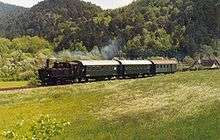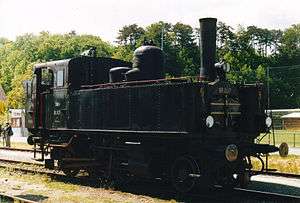KkStB Class 99
|
91.107 in Pottenstein; special trip on the occasion of the opening of the Freiland–Türnitz line, 19 May 2001 | |||||||||||||||||||||||||||||||||
| |||||||||||||||||||||||||||||||||
| |||||||||||||||||||||||||||||||||
| |||||||||||||||||||||||||||||||||
The steam locomotives of kkStB Class 99 were 2-6-0T tank engines operated by the Imperial Royal Austrian State Railways (kaiserlich-königliche österreichische Staatsbahnen), or k.k.StB, for duties on secondary routes (Nebenbahnen) and branch lines (Lokalbahnen).
History
In 1897 the delivery of the kkStB Class 99 began. It fulfilled the requirements placed on it for a 300 PS (296 hp; 221 kW) engine and, with good coal it even reached 400 PS. By 1908 69 units had been built and, between 1903 and 1907 another 5 units went to the NÖLB as Class 2, which were deployed to the Korneuburg - Hohenau Lokalbahn. The kkStB engines were to be found in the Karlsbad, Laibach and Knittelfeld areas. Five 99s were employed on the Vienna suburban lines in charge of light trains. Of note was the use of the Karlsbad locomotives on the inclines of the Schlackenwerth–Joachimsthal Lokalbahn with its inclines of up to 50 Promille (5% or 1:20).
Between 1908 and 1913, 20 locomotives of Class 199 were built, an evolutionary development, that had a greater water capacity and could carry more coal. These engines worked the lines Bolzano-Meran, Krems-Mauthausen and on the changeover (Wechselstrecke) of the Aspangbahn. The same type was also built in nine examples for the NÖLB as Class 102 and they were employed on the Freiland–Türnitz line (c.f. Leobersdorfer Bahn).

After World War I, Italy was given eight engines (FS Class 876 and 877), Yugoslavia 11 and Czechoslovakia 34 units of these classes. 34 locomotives remained with the BBÖ and retained their kkStB numbers. In 1923 in the wake of nationalisation the locomotives of the NÖLB went into the BBÖ, where they were given numbers 99.70–74 (ex-Class 2) and 199.21–29 (ex-Class 102).
In the inter-war years, these locomotives were mainly employed on the secondary lines of Wels, Bad Radkersburg and Pöchlarn, but also on many other branch lines. On being taken over by the Deutsche Reichsbahn in 1938 the locomotives in Class 99 were allocated the numbers 98.1301–1324, and the Class 199s the numbers 98.1352–1374.
In 1953 the Austrian Federal Railway (ÖBB) took over 15 Class 99s as ÖBB Class 91 and 9 Class 199s as ÖBB Class 91.1. The last two digits of the serial numbers remained the same as with the BBÖ. In 1960 they began to concentrate the classes, so that the majority of locomotives were to be found in Neustadt and Mürzzuschlag. By 1968 all bar 3 locomotives had been retired.
The last area of operations for these 3 locomotives was the Mürzzuschlag - Neuberg branch line. In 1972 they, too, were withdrawn.
